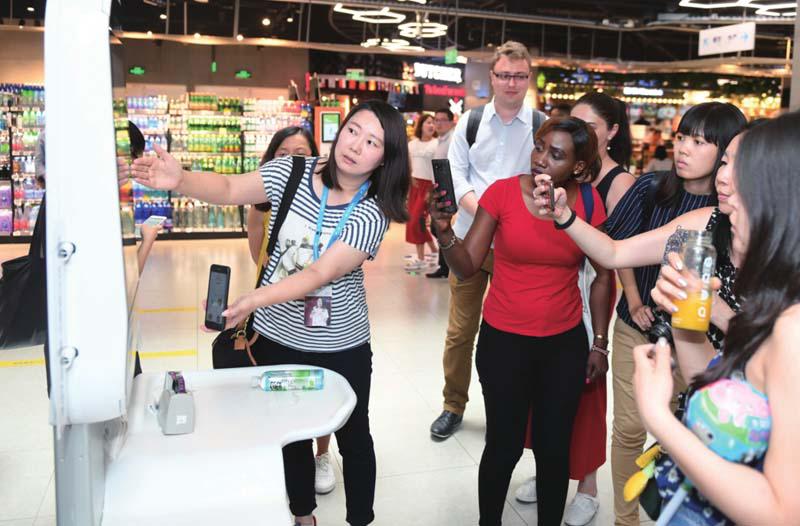LEAPS AND BOUNDS
2019-03-10ByMichaelZakkour
By Michael Zakkour

In 2014, I wrote a book titled Chinas Super Consumers: What 1 Billion Customers Want and How to Sell It to Them. The book explained and examined the development of Chinas consumer and retail evolution, from the beginning of the reform and opening-up era to the early days of the e-commerce explosion.
Some of the facts and statistics highlighted in the book left casual observers of China, its economy and its development into the second largest economy in the world in disbelief including: nearly 700 million consumers with significant disposable income; 1 billion smart devices in use; social media apps with 1 billion users; the second largest luxury goods market in the world; a digital fi rst/mobile fi rst consumer society; and near universal adoption of digital payments, just to name a few.
In summary, the book told the tale of how the evolution and growth of Chinese consumption and retail changed the way Chinese citizens shopped, lived, developed new identities and related to the outside world. It also told the stories of the entrepreneurs, retailers and brands that were transforming the Chinese economy through consumption and services.
This development happened in several stages.
Stage One, 1990-94: Proto-Retail and Consumer Culture. This period was fueled by the first reforms in retail, which led to a surge of privatization; the opening of the Chinese market to the outside world; the initial success of Chinese entrepreneurs and business owners; new wealth created by manufacturing and exports; and the reform of regulations that allowed for greater freedom for foreign brands and retailers.
Domestic retailers emerged and the first wave of foreign brands and retailers entered China primarily in the form of foreign luxury brands. This stage started with roughly 15 million consumers and ended with 30 million consumers with signifi cant disposable income.
Stage Two, 1994-2004: Early Days of Modern Retail Development. New malls and department stores started to emerge in large numbers and the second wave of foreign brands and retailers entered the Chinese market. This period started with roughly 35 million consumers and ended with nearly 200 million consumers with signifi cant disposable income.
Stage Three, 2004-15: The Age of Chinas Super Consumers. The largest and most important consumer demographic since the original U.S. super consumers of the post-World War II era emerged.
This was the time of exponential growth in retail infrastructure buildout and modernization; conspicuous consumption; higher rates of spending; and the growth of the sheer number of Chinese consumers with disposable income(700 million). Thousands of new foreign brands and retailers entered China and engaged Chinese consumers.
But most importantly, the emergence of mass e-commerce and digital payment options kickstarted a digital consumer revolution. Alibaba, JD.com, Tencent, Baidu and others started laying the foundation for the following stage.
Stage Four, 2015-19: The Age of the Chinese Digital Super Consumer. China has evolved its modern retail and consumption economy on the foundation of what we used to call e-commerce, but now categorize as digital commerce and new retail. There are now close to 800 million Chinese consumers with signifi -cant disposable income and nearly 700 million digital consumers. Moreover, Chinese digital commerce is the most advanced in the world.
There can be no argument about the fact that the emergence, growth and evolution of e-commerce were key to building the new gen- eration of Chinas super consumers.
But how did e-commerce become digital commerce and new retail?
At first, it wasnt necessarily what China had or what other countries did that led to the fastest adoption rates of e-commerce, digital payments and social media apps (as operating systems for life). It was what China didnt have that became an enabler and an advantage.
China had no modern retail legacy infrastructure to overcome. Even as Chinas retail and consumer economy started to develop and then boom in the late 1990s and early 2000s, modern retail infrastructure development was not keeping pace. Yes, malls and department stores were built at a rapid pace, and this helped, but the store-marketing-supply chain structures of fully developed retail markets were not yet in place. The arrival of e-commerce fi lled the gaps quickly. Most new consumers were “born” into e-commerce.
There was no legacy of communications systems to overcome in China. The vast majority of Chinese citizens did not own landlines, personal computers or primitive mobile devices in the 1990s and 2000s. When affordable, highly functional smartphones came on the market, China embarked on the fastest adoption of a new technology in human history. In less than 10 years, there were more than 1 billion smartphones in use. These smartphones were the perfect compliment to and enabler of e-commerce.
China had no traditional banking, finance and payment systems to overcome. During the early and middle development stages of retail and consumption in the country and until the introduction of digital escrow accounts to complete consumer-to-consumer e-commerce transactions in the mid-2000s, almost all retail was conducted on a cash-and-carry basis. Credit cards, checking accounts and debit cards were not a big part of peoples everyday lives. The introduction of easy-to-use, ubiquitous and eventually, QR code-based payment systems voided the need for credit cards, checkbooks and debit accounts.

The end result was the acceleration of Chinese consumption by way of technology and then the creation of Chinas digital super consumers. Today, China has advanced even further in terms of how products are made, moved, sold and experienced.
First was the evolution of e-commerce into digital commerce. The difference between e-commerce and digital commerce is as follows: e-commerce is an alternative to buying a product or service in a store or other physical environments. A consumer can choose to buy a handbag in a store, or on the brands website or on an online marketplace like Tmall.
Digital commerce includes far more than a choice of where to complete a transaction. It includes digital payments, digital promotions and marketing, brands using a mix of environments(marketplaces, owned domains, third-party retailers) to reach the consumer, and digitization of customer services, fulfillment and logistics.
China today has progressed from digital commerce to new retail. Digital commerce has been the fastest growing segment of retail and consumption in China for the last 10 years. In many categories, digital is dominant. It already represents more than 30 percent of retail (as compared to 12 percent in the United States) and is heading toward 40-50 percent of all retail in the next five years.
The introduction of new retail has brought forth a revolutionary concept, although physical environments (stores and human social spaces) still matter. In fact, they matter more than ever and in new and exciting ways.
As Jack Ma, founder of Alibaba Group, famously defined it, new retail is “the complete integration of online, offline, technology and logistics for a single value stream.” New retail was born in China three years ago and is now going global.
Alibaba, JD.com and Tencent are building massive new retail ecosystems that include commerce related online and offline environments, technology and IT, logistics and supply chains, and media and entertainment.
New retail connects all four major functions to produce a single result: consumer-centricity, where providing consumer convenience, customization, choice of environments, an endless variety of products, entertainment and a suite of services is the goal.
The future of Chinas consumer and service economy will be driven by new retail. Innovations in payments, services, technology, fulfillment, online and offline integration and on-demand delivery will boost consumption the same way retail reforms in the 1990s and 2000s did.
Continued investment in artificial intelligence and data science; domestic and global logistics; the blend of services, entertainment and transactions; cross-border digital commerce; and a laser focus on the consumer will ensure the growth of Chinas economy and increasing levels of disposable income. A virtuous cycle of innovation, wealth creation, consumption and innovation will be the end result. That is the opportunity China has on a domestic and international stage and it is the blueprint for the role Chinas digital super consumers can play in global growth.
